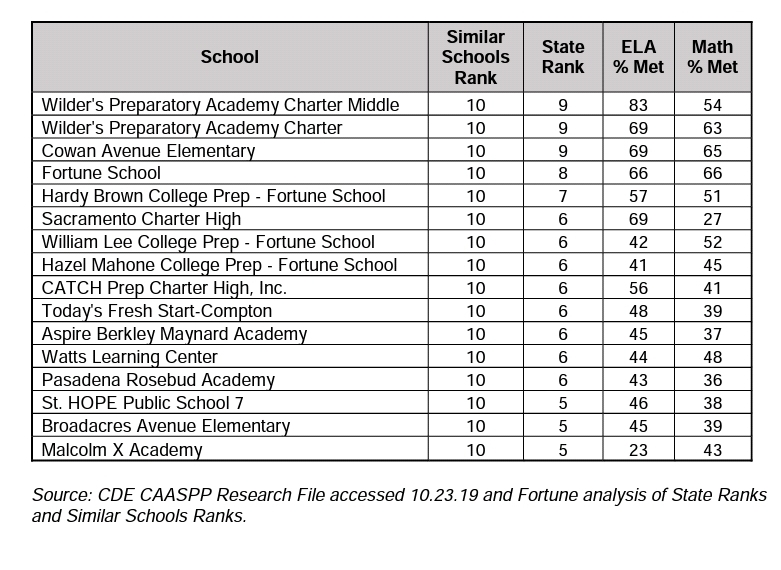
For educators, equity has become an industry. They are offered tons of data, research and training on how to build equity in district-run schools. But with all this talk of equity, what has changed? I got a taste of the answer as a panelist at the recent Association of California School Administrators leadership summit.
California’s 2019 statewide student achievement data just came out. When I disaggregated the data to see the results for Black students, I found that [pullquote position="right"]67% of Black students can’t read or write at grade level and 80% of Black students can’t do math at grade level.[/pullquote] There was little to no progress from last year’s data—only a fraction of a percentage point gain in reading.
All the unconscious bias training, "White Fragility" book clubs, African American Parent Advisory Councils and a host of other equity offerings moved the statewide needle less than a percentage point!
I assumed the school leaders in attendance would have cohesive action plans explaining how they were going to combat inequities in district-run schools. Very quickly, I found I was wrong. Many people in this realm seemed not to understand how to hold their teachers responsible or accountable for creating equitable environments for student learning.
[pullquote]After decades of opportunity to change, they are still trying to figure out how to treat Black children equitably.[/pullquote] This shows how little progress we have made in outgrowing the practice of viewing Black children as “the other.” I’m left with a question: However well-intentioned these equity consumers are, how can they properly educate children they fundamentally don’t understand?
Without a Change of Hearts and Minds, It’s All Theory Without Action
Take school districts’ most common response to poor academic achievement: creating African American Advisory Committees. These advisory committees are a public relations and political response to poor student achievement. The Black stakeholders who participate feel heard. Some of them may even get contracts to do work with Black children. But in the end, learning outcomes for Black children do not actually improve.
Though the equity industry has disillusioned many of us, [pullquote]there are schools showing us how to educate Black children successfully.[/pullquote] According to the California Department of Education and CAASPP scores, 16 schools where the majority of children are African American and low-income are in the top half of statewide student performance. That is four more schools than last year. These results show there are California educators who know how to teach Black children and are improving at it over time.

It seems to me that these models should be replicated, especially since they are located in communities with the students whom the system has traditionally failed. There’s your million-dollar equity answer.
Ironically, the equity industry ignores the existence of these schools, preferring to lumber along in the dark, as if there are no public school educators in California who know who to educate black children to a level of excellence. Maybe these schools get ignored by the system because 14 of the 16 are non-profit, public charter schools.
These are the schools that Elizabeth Warren and Bernie Sanders would bar Black parents from choosing for our children. These politicians want to curry favor with teacher unions more than they want to support Black parents whose children are suffering in failing schools. [pullquote position="right"]The right thing to do is to learn from all 16 of these schools, both non-profit public charter and district-run, that have cracked the code on Black student achievement.[/pullquote]
Our children require a right-now action, not a waiting-game response.
Replicating these schools shouldn’t take two more decades or so of conferences attempting to bridge the access and opportunity gap. But at the administrators’ conference, I rediscovered what I already knew—that the traditional school system has no desire for immediate change.
As parents, we can stop leaving our children in failing systems and institutions and start voting with our feet. We may not change traditional district behavior, but we can change ours. Our children’s futures depend on it.
Christina Laster is a civil rights activist and humanitarian who serves as Director of Policy and Legislation for the National Parents Union. She is also the founder of the Inland Empire and San Diego Parent Unions, a former statewide community organizer with the California Policy Center, and a Black parent and grandparent in Southern California. Christina was formerly an executive committee member of the California Hawaii NAACP, the Education chairwoman and Youth Council advisor of Southwest Riverside County NAACP.
If you have a child with disabilities, you’re not alone: According to the latest data, over 7 million American schoolchildren — 14% of all students ages 3-21 — are classified as eligible for special...
The fight for educational equity has never been just about schools. The real North Star for this work is providing opportunities for each child to thrive into adulthood. This means that our advocacy...
The story you tell yourself about your own math ability tends to become true. This isn’t some Oprah aphorism about attracting what you want from the universe. Well, I guess it kind of is, but...
Your donations support the voices who challenge decision makers to provide the learning opportunities all children need to thrive.
Ed Post is the flagship website platform of brightbeam, a 501(c3) network of education activists and influencers demanding a better education and a brighter future for every child.
© 2020–2024 brightbeam. All rights reserved.